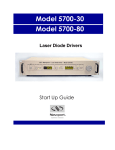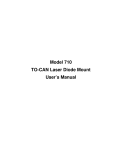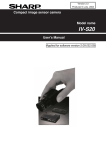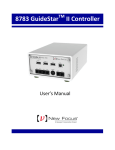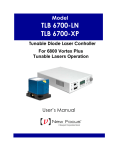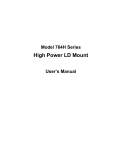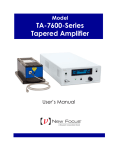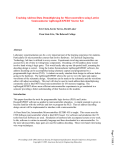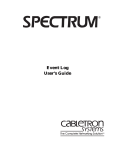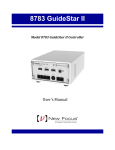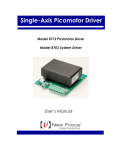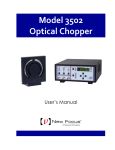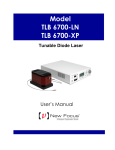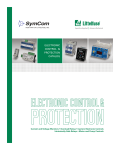Download Lab Source Manual - Newport Corporation
Transcript
U S E R’S G U I D E Lab Source Manual Models LS-1 and LS-2 1791 Deere Avenue • Irvine, CA 92606 • USA phone: (949) 863-3144 • fax: (949) 253-1680 e-mail:[email protected] • www.newport.com Declaration of Conformity We declare that the accompanying product, identified with the mark, complies with requirements of the Electromagnetic Compatibility Directive, 2004/108/EC and the Low Voltage Directive 2006/95/EC. Model Numbers: LSx Series Year mark affixed: 2013 Type of Equipment: Electrical equipment for measurement, control and laboratory use in industrial locations. Manufacturer: PD-LD, Inc. 30-B Pennington-Hopewell Road Pennington, NJ 08534 United States of America Importer: Newport Corporation 1791 Deere Avenue Irvine, CA 92606 United States of America Standards Applied: Compliance was demonstrated to the following standards to the extent applicable: BS EN61326-1: 2006 “Electrical equipment for measurement, control and laboratory use – EMC requirements” (Laboratory) This equipment meets the CISPR 11:2009+A1:2010 Class A Group 1 radiated and conducted emission limits. BS EN 61010-1:2010, “Safety requirements for electrical equipment for measurement, control and laboratory use”. Uri Abrams President PD-LD, Inc. 30-B Pennington-Hopewell Road Pennington, NJ 08534 USA 2 Mark Carroll Sr. Director, Instruments Business Newport Corporation 1791 Deere Ave, Irvine, CA 92606 USA Warranty Newport warrants that this product will be free from defects in material and workmanship and will comply with Newport’s published specifications at the time of sale for a period of one year from date of shipment. If found to be defective during the warranty period, the product will either be repaired or replaced at Newport’s option. To exercise this warranty, write or call your local Newport office or representative, or contact Newport headquarters in Irvine, California. You will be given prompt assistance and return instructions. Send the product, freight prepaid, to the indicated service facility. Repairs will be made and the instrument returned freight prepaid. Repaired products are warranted for the remainder of the original warranty period or 90 days, whichever first occurs. Limitation of Warranty The above warranties do not apply to products which have been repaired or modified without Newport’s written approval, or products subjected to unusual physical, thermal or electrical stress, improper installation, misuse, abuse, accident or negligence in use, storage, transportation or handling. This warranty also does not apply to fuses, batteries, or damage from battery leakage. THIS WARRANTY IS IN LIEU OF ALL OTHER WARRANTIES, EXPRESSED OR IMPLIED, INCLUDING ANY IMPLIED WARRANTY OF MERCHANTABILITY OR FITNESS FOR A PARTICULAR USE. NEWPORT SHALL NOT BE LIABLE FOR ANY INDIRECT, SPECIAL, OR CONSEQUENTIAL DAMAGES RESULTING FROM THE PURCHASE OR USE OF ITS PRODUCTS. First printing 2014 © 2014 by Newport, Irvine, CA. All rights reserved. No part of this manual may be reproduced or copied without the prior written approval of Newport. This manual has been provided for information only and product specifications are subject to change without notice. Any change will be reflected in future printings. Newport 1791 Deere Avenue Irvine, CA, 92606 USA Part No. 90059942 Rev A 3 Confidentiality & Proprietary Rights Reservation of Title The Newport programs and all materials furnished or produced in connection with them (“Related Materials”) contain trade secrets of Newport and are for use only in the manner expressly permitted. Newport claims and reserves all rights and benefits afforded under law in the Programs provided by Newport. Newport shall retain full ownership of Intellectual Property Rights in and to all development, process, align or assembly technologies developed and other derivative work that may be developed by Newport. Customer shall not challenge, or cause any third party to challenge the rights of Newport. Preservation of Secrecy and Confidentiality and Restrictions to Access Customer shall protect the Newport Programs and Related Materials as trade secrets of Newport, and shall devote its best efforts to ensure that all its personnel protect the Newport Programs as trade secrets of Newport. Customer shall not at any time disclose Newport’s trade secrets to any other person, firm, organization, or employee that does not need (consistent with Customer’s right of use hereunder) to obtain access to the Newport Programs and Related Materials. These restrictions shall not apply to information (1) generally known to the public or obtainable from public sources; (2) readily apparent from the keyboard operations, visual display, or output reports of the Programs; 3) previously in the possession of Customer or subsequently developed or acquired without reliance on the Newport Programs; or (4) approved by Newport for release without restriction. Trademarks The Newport logo and name are registered trademarks of Newport Corporation in Mexico, Israel, Singapore, European Union, Taiwan, Hong Kong, China, Japan, Korea, Canada, Australia, and the United States. Service Information This section contains information regarding factory service for the source. The user should not attempt any maintenance or service of the system or optional equipment beyond the procedures outlined in this manual. Any problem that cannot be resolved should be referred to Newport. 4 Technical Support Contacts North America Newport 1791 Deere Avenue Irvine, CA 92606 Telephone: (877) 835-9620 Europe Newport/MICRO-CONTROLE S.A. Zone Industrielle 45340 Beaune la Rolande, FRANCE Telephone: (33) 02 38 40 51 56 Asia Newport Opto-Electronics Technologies 中国 上海市 爱都路 253号 第3号楼 3层 C部位, 邮编 200131 253 Aidu Road, Bld #3, Flr 3, Sec C, Shanghai 200131, China Telephone: +86-21-5046 2300 Fax: +86-21-5046 2323 Newport Corporation Calling Procedure If there are any defects in material or workmanship or a failure to meet specifications, promptly notify Newport’s Returns Department by calling 1-800-222-6440 or by visiting our website at www.newport. com/returns within the warranty period to obtain a Return Material Authorization Number (RMA#). Return the product to Newport Corporation, freight prepaid, clearly marked with the RMA# and we will either repair or replace it at our discretion. Newport is not responsible for damage occurring in transit and is not obligated to accept products returned without an RMA#. E-mail: [email protected] When calling Newport Corporation, please provide the customer care representative with the following information: Your Contact Information Serial number or original order number Description of problem (i.e., hardware or software) To help our Technical Support Representatives diagnose your problem, please note the following conditions: Is the system used for manufacturing or research and development? What was the state of the system right before the problem? Have you seen this problem before? If so, how often? Can the system continue to operate with this problem? Or is the system non-operational? Can you identify anything that was different before this problem occurred? 5 Contents Preface10 Important Symbols Used in this Manual 10 1. Safety 11 1.1 Laser Safety Precautions��������������������� 11 1.2 Optical Safety��������������������������������������� 12 1.3 EMC Considerations��������������������������� 14 2. Description 15 3. Key Performance Features 15 4. Specifications 16 5. Performance Data 18 6. Mechanical Dimensions 20 7. Handling and Installation 20 7.1 Optical Connection����������������������������� 20 7.2 Thermal Considerations��������������������� 21 7.3 Operation��������������������������������������������� 21 7.3.1 Using The Lab Source����������������������� 21 8. User Interface 22 8.1 LED Indicators������������������������������������� 22 8.2 Front Panel Menu and Key Operation for LS-1���������������������������������������������������������������� 22 8.3 Front Panel Menu and Key Operation for LS-2������������������������������������������������������� 22 6 8.4 The Main Screen����������������������������������� 23 8.5 Selecting APC or ACC Mode ��������������� 23 8.5.1 APC (Automatic Power Control) Mode����������������������������������������������������������� 23 8.5.2 ACC (Automatic Current Control) Mode����������������������������������������������������������� 23 8.6 Shutter Time����������������������������������������� 24 8.7 Analog Input����������������������������������������� 24 8.8 Modulation Input��������������������������������� 24 8.9 Shutter Input ��������������������������������������� 25 8.10 Laser On / Off������������������������������������� 25 8.11 I-Lock ������������������������������������������������� 25 8.12 Power Button������������������������������������� 25 8.13 Emergency Stop Button ������������������� 26 8.14 Key Lock Switch��������������������������������� 26 8.15 Alarms������������������������������������������������� 26 8.16 Troubleshooting��������������������������������� 28 9. Lab Source Control Panel Software 29 9.1 System Requirements������������������������� 29 9.2 Installing the USB Driver��������������������� 29 9.3 Installing the Lab Source Control Panel��������������������������������������������� 30 9.4 Determining the Proper Com Port for the Lab Source Control Panel������������� 30 9.5 Lab Source Control Panel and Initial Setup���������������������������������������������������������� 31 9.6 Lab Source Control Panel Functions� 32 9.7 Lab Source Firmware Updates ����������� 32 9.8 Control Panel Software Update���������� 32 7 10. Communications Protocol 33 10.1 Port Settings��������������������������������������� 33 10.2 Initialize Message and Link Status � 33 10.3 Command Sequence ����������������������� 33 10.4 Receiving Data ����������������������������������� 34 10.5 Error Messages ��������������������������������� 34 10.6 Monitoring Commands ������������������� 34 10.7 Setting Commands ��������������������������� 38 10. mmand: SST<><XXXXXX><CR> ������� 41 11. Maintenance and Service 42 11.1 Enclosure Cleaning��������������������������� 42 11.2 Technical Support ����������������������������� 42 11.3 Service ����������������������������������������������� 43 11.4 Obtaining Service������������������������������� 43 11.5 Warranty��������������������������������������������� 43 11.6 Service Form ������������������������������������� 44 8 Preface This manual contains user information for Newport Corporation’s LS1 and LS2 Lab Source modules. The single-source LS1 is a laboratory instrument designed for Raman spectroscopy and other applications requiring the use of a highly stabilized laser, while the dual-source LS2 module’s applications include Surface Enhanced Raman Differential Spectroscopy (SERDS) analysis. Important Symbols Used in this Manual This symbol is used to alert the operator to the presence of dangerous voltages associated with the laser that may be of sufficient magnitude to constitute a risk of electric shock. This symbol is used to alert the operator to the danger of exposure to hazardous visible or infrared (invisible) laser radiation. This symbol is used to show cautions or important operating instructions. Performing any procedures other than those specified in this manual may result in hazardous radiation exposure. 9 This symbol on the product or on its packaging indicates that this product must not be disposed of with regular waste. Instead, it is the user responsibility to dispose of waste equipment according to the local laws. The separate collection and recycling of the waste equipment at the time of disposal will help to conserve natural resources and ensure that it is recycled in a manner that protects human health and the environment. For information about where the user can drop off the waste equipment for recycling, please contact your local Newport Corporation representative. The presence of the CE Mark on a product means that this instrument has been designed, tested and certified compliant to all applicable European Union (CE) regulations and recommendations. 1.Safety Embedded lasers emit Class IV radiation. Extreme care should be exercised during operation. Only personnel familiar with the safety precautions and practices in this manual should operate the laser products. 1.1 Laser Safety Precautions Embedded lasers are Class IV laser products. Average powers exceeding 500mW are obtainable with the Lab Source devices. Always wear proper eye protection when operating. Laser safety glasses can present a hazard as well as a benefit: while they protect the eye from potentially damaging exposure, they block light at the laser wavelength, which prevents the operator from seeing the beam. Therefore, use extreme caution even when using safety glasses. 10 Avoid eye or skin exposure to direct or scattered radiation from the laser. Personnel operating these laser products should be familiar with and follow the recommendations given below and in this manual: 1. Always wear laser safety eyewear, which is optically dense at the wavelength of operation per site Laser Safety Officer calculation. 2. Never look directly into the beam or at specular reflections even while wearing protective eyewear. 3. Use safety interlocks to restrict access to laser areas and prevent unauthorized use of the lasers. 4. Post warning signs for Class IV laser products. 5. Do not subject any body parts to direct radiation. 1.2 Optical Safety Laser light, because of its special properties, poses safety hazards not associated with light from conventional sources. The safe use of lasers requires that all laser users, and everyone near the laser system, are aware of the dangers involved. The safe use of the laser depends upon the user being familiar with the instrument and the properties of coherent, intense beams of light. Direct eye contact with the output beam from the laser will cause serious eye damage and possible blindness. The greatest concern when using a laser is eye safety. In addition to the main beam, there are often smaller beams present at various angles near the laser system. These beams are formed by specular reflections of the main beam at polished surfaces such as lenses or beam splitters. While 11 weaker than the main beam, such beams may still be sufficiently intense to cause eye damage to nerve or blood vessels. Laser beams often are powerful enough to burn skin, clothing or paint. They can ignite volatile substances such as alcohol, gasoline, ether and other solvents, and can damage light-sensitive elements in video cameras, photo-multipliers and photodiodes. The laser beam can ignite substances in its path, even at some distances. The beam may also cause damage if contacted indirectly from reflective surfaces. For these reasons, and others, the user is advised to follow the precautions below and in this manual. 1. Observe all safety precautions in this manual. 2. Extreme caution should be exercised when using solvents in the area of the laser. 3. Limit access to the laser to qualified users who are familiar with laser safety practices and who are aware of the dangers involved. 4. Never look directly into the laser light source or at scattered laser light from any reflective surface. Never sight down the beam into source. 5. Maintain experimental setups at low heights to prevent inadvertent beam-eye encounter at eye level. 6. As a precaution against accidental exposure to the output beam or its reflection, those using the system should wear laser safety glasses as required by the wavelength being generated. 7. Avoid direct exposure to the laser light. The intensity of the beam can easily cause flesh burns or ignite clothing. 8. Use the laser in an enclosed room. Laser light presents a potential hazard if not confined. 12 9. Post warning signs in the area of the laser beam to alert those present. 10.Advise all those using the laser of these precautions. It is good practice to operate the laser in a room with controlled and restricted access. Performing any procedures other than those specified in this manual may result in hazardous radiation exposure. 1.3 Warnings Notice that main disconnect is removing the power cord. Position the product so you have access to main power cord. Do not replace the detachable MAINs supply cord with an inadequately rated cord. If equipment is used in a manner not specified by the manufacturer, the protection provided by the equipment may be impaired. 1.4 EMC Considerations The LS-1 and LS-2 products are intended for use in an industrial laboratory environment. Use of these products in other environments, such as residential, may result in electromagnetic compatibility difficulties due to conducted as well as radiated disturbances. The LS-1 and LS-2 products are designed to operate in a controlled electromagnetic environment; i.e., where R.F. transmitters such as mobile telephones may not be used in close proximity. 13 2.Description Lab Source is the optimum solution for accurate, sure detection of Raman spectra in ultra-sensitive measurement systems. Based on highly stable and proprietary Volume Bragg Grating® (VBG™) technology, Lab Source is a convenient, narrowband, stable high-power laser light source ideally suited for Raman spectroscopy. When configured with a pair of Shifted Excitation Raman Difference Spectroscopy (SERDS) lasers, Lab Source helps to eliminate fluorescence background. This provides the user with unsurpassed signal-to-noise performance without a need for costly tunable lasers. Utilize Lab Source for Shifted Excitation Raman Difference Spectroscopy (SERDS) and realize the power and sensitivity that can be achieved. 3. Key Performance Features • High power lasers, up to 1 Watt • Narrow line width, < 0.1 nm • SERDS option available • Excellent wavelength stability, +/- 0.005 nm • Excellent power stability, +/- 0.5 % • Easy laser modulation, safe operation • Front panel display 14 4.Specifications 4.1 Optical Characteristics Comments Standard Wavelengths (nm) 647 785 830 SERDS pairs available Yes Yes SERDS pair (λ2 – λ1) (nm) 0.1 – 1.0 Center λ tolerance (nm) +/- 0.5 Wavelength stability (nm) +/- 0.005 Line width (nm) Line width (cm-1) Custom adjustable Over 8 hours Typical 1.3; max. 2.4 >40 Power / Electrical Characteristics Output from fiber (mw) Adjustability % full power >500 >600 >600 Comments >800 1mA APC Adjustment Resolution 5mW Output power stability % +/- 0.5 Noise RMS % < 0.25 Noise P – P % <1 Over 8 hours Digital modulation 10 kHz (ACC Mode) Analog modulation 10 Hz (ACC Mode) Power consumption (W) Warm up time (min) Multimode lasers 10 - 100 ACC Adjustment Resolution 4.3 Multimode lasers Typical 0.08; max. 0.15 ASE suppression (dB) 4.2 1064 Yes 30 1 General and Environmental Characteristics CDHR classification Operating temperature C Storage temperature C Humidity no condensing % Class IV 10 – 40 LS1 (10-35 LS2) -10 – 60 < 95 Environment Indoor Use Only Interfaces USB 2.0, BNC Altitude Pollution Degree Below 2000 meters 2 15 4.4 Mechanical Characteristics Dimensions (mm) 84 x 174 x 190 Weight (g) ~1200 to 1500 Display size (mm) 4.5 Connector type 4.6 Other available FC/PC standard Other available Comments 100-240 VAC 50/60Hz AC Mains 0.5 A Analog Input 0-5V Modulation Input 5V Logic Level Shutter Input 5V Logic Level 4.7 Optical Shutter Characteristics Switching time (ms) < 10 Crosstalk (dB) < - 55 16 Comments 105 um core; 0.22 NA Electrical Characteristics Line Voltage Varies per version 58 x 12 Output Fiber Characteristics Fiber type Comments The Lab Source’s internal 120/240VAC power supply can be used in both North American and International applications. Comments 5. Performance Data Example of a SERDS Laser Pair: Center Wavelength Separation 1nm 10 0 Laser 1 Laser 2 Relative Power (dB) -10 -20 -30 -40 -50 780 781 782 783 784 785 786 787 788 789 790 Wavelength (nm) Wavelength Drift Over 12 Hours 0.03 Wavelength shift (nm) 0.02 0.01 0 -0.01 -0.02 -0.03 0:00 1:00 2:00 3:00 4:00 5:00 6:00 7:00 8:00 9:00 10:00 11:00 12:00 Time (hh:mm) 17 Power Stability Over 12 Hours 2.0 1.5 Power Drfit (%) 1.0 0.5 0 -0.5 -1.0 -1.5 -2.0 0:00 1:00 2:00 3:00 4:00 5:00 6:00 7:00 8:00 9:00 10:00 11:00 12:00 Time (hh:mm) Power Stabilization From Cold Start 600 500 Power (mW) 400 300 200 100 0 0 5 10 15 Time (hh:mm) 18 20 25 30 6. Mechanical Dimensions 1. Warning 2. Radiation statement 3. Invisible laser radiation, safety Information 1 2 3 4. “Do not operate without fiber connected” 4 5. Laser emission indicator 5 6 6. Emergency stop button 7. Laser danger warning 7 8 8. Laser aperture 9. WEEE Symbol 10. Model ID Label Dimensions (mm / inch) Height: 84 / 3.30 Width: 174 / 6.85 Depth: 190 / 7.45 10 9 7. Handling and Installation 7.1 Optical Connection If fiber coupled, use a fiber jumper that has the same core size as the Lab Source. Standard fiber is 105/125 0.22NA multimode fiber with FC/APC connector. The other end of the fiber can have any appropriate connector suitable for required operation (preferably with an angle polish). The fiber end face must be free of debris. The presence of debris on the fiber end face will cause potential permanent damage to the end face resulting in loss of optical performance. 19 When connecting the Lab Source using an external fiber connector, ensure that: • The Lab Source is turned off before the fiber connector is attached. • The end face of the ferrule is clean and free of debris & solvents. • The end face must be cleaned using industry standard methods before each mating. • No mechanical pressure is applied to the window of free space units. 7.2 Thermal Considerations The Lab Source uses internal fans to ensure proper thermal control and reliability. The vents under the front bottom and the rear fan must remain UNOBSTRUCTED or permanent damage to the Lab Source may result 7.3 Operation The Lab Source configuration may be accessed by using the front panel keys, the provided PC application, or through commands issued from windows terminal, or your OEM software system. 7.3.1 Using The Lab Source • Connect the Lab Source to the fiber probe. • Apply power to the Lab Source. Switch key-lock to “on” position and press the power button. • The Lab Source will power up and operate using the settings that were last used. • By default both lasers are turned off. Power on each laser as desired. • To change the settings access the menu (steps in sections 9.2 and 9.3) or using the Lab Source Control Panel Software (steps in section 10). 20 8. User Interface 8.1 LED Indicators LSR 1: Energized when Laser 1 is powered on (shown as LSR on LS-1). LSR 2: Energized when Laser 2 is powered on (not used on LS-1). EXT: Energized when an external input is selected. DANGER LASER EMISSION: Energized when a laser is on and the shutter is open. 8.2 Front Panel Menu and Key Operation for LS-1 8.3 Front Panel Menu and Key Operation for LS-2 21 8.4 The Main Screen The main screen indicates the status of the laser and the setup. If APC is selected, the laser output power can be adjusted using the Up/Down keys. If ACC mode is selected, the laser bias current can be adjusted using the Up/Down keys. When setting, the mW or mA blinks. When setting is complete, the mW or mA is steady and the actual value is displayed. When a laser is on and the shutter key is pressed, the shutter opens and the time counts down. The shutter closes when the shutter reaches 0mS. ILK blinks on the main screen when the I-lock input is turned on, and is open disabling the lasers. 8.5 Selecting APC or ACC Mode Pressing the Menu Key while in the main screen shows the first menu item (see section 9.2 and 9.3). This selects ACC or APC mode. 8.5.1APC (Automatic Power Control) Mode When APC mode is selected, the output power (mW) entered is output by the laser. Internal photo diode and temperature feedback is used to obtain a linear, repeatable output response. APC output resolution is 5mW. 8.5.2ACC (Automatic Current Control) Mode When ACC mode is selected, the set laser current (mA) is driven through the laser and temperature feedback is used to help obtain a repeatable output response. The internal photo diode is used to display the actual output power generated by the laser. Since the internal photo diode is not used for feedback, the laser output may change slightly in ACC mode; the output power should always be used as the reference. 22 8.6 Shutter Time The Shutter Time adjustment is the second menu item (see section 9.2 and 9.3). The shutter time can be adjusted from 0-600000mS. To make setting the times easier, the shutter key can be pressed and the time setting will be indexed in 100ms, 1000ms, 10000ms, 100000ms, and INDEF (indefinite). The Up/Down keys can be used to adjust to the exact value. When the time is set beyond 600000ms, the Indefinite mode is entered. The Indefinite mode means that the shutter will stay open indefinitely or until the shutter key is pressed again. 8.7 Analog Input The Analog Input on/off selection is the third menu item (see section 9.2 and 9.3). When the Analog Input is turned on in the menu, the output power (APC) or bias current (ACC) is adjustable via the analog input BNC on the rear of the instrument. When in APC mode the input scaling is as follows: 0-5V = 0-Pmax (maximum power allowed for the laser). When in ACC mode the input scaling is as follows: 0-5V = 0-2000mA, but the laser current will be limited to the maximum laser current allowed by the factory setup. 8.8 Modulation Input The Modulation Input on/off selection is the fourth menu item (see section 9.2 and 9.3). When the Modulation Input is turned on in the menu, only ACC mode is used to control the `. When the Modulation Input is turned on in the menu, if the input is logic low (< 0.75VDC), the laser will turn off; when the input is logic high (>1.25VDC), the laser will turn on. When modulation mode is selected, the Photo Diode feedback is not used and the output power is roughly estimated from the ACC laser bias current. A maximum modulation frequency of 10KHz is achievable with the modulation input. 23 8.9 Shutter Input The Shutter Input on/off selection is the fifth menu item (see section 9.2 and 9.3). When the Shutter Input is turned on in the menu, if the input is logic low (< 0.75VDC), the laser shutter will close; when the input is logic high (>1.25VDC), the shutter will open. 8.10 Laser On / Off The Laser on/off selection is the sixth menu item (see section 9.2 and 9.3). When the Laser is turned on it will be powered up and ready for use. When it is turned off, the laser is idle (its temperature is maintained, but no bias current is applied). When the laser is turned off, the shutter cannot be opened. As described in the menu diagram in section 9.2 and 9.3, the selected laser can toggled between on and off by pressing the Menu and Shutter Keys together. 8.11I-Lock The I-LOCK on/off selection is the seventh menu item (see section 9.2 and 9.3). The I-Lock input turns the selected lasers off when the I-Lock input is not jumpered. When the input is jumpered, the user is able to turn ON the selected lasers. The interlock is a digital input with a 10K Ohm pull-up resistor to 5VDC; when the input is logic low (< 0.75VDC), the laser will turn off; when the input is logic high (>1.25VDC), the laser will turn on. The input can withstand up to 10VDC, but it is designed to interface to 5V logic systems. 8.12 Power Button The Lab Source power button is located on the lower right of the front panel. It puts the unit into a low power (~2 Watts Consumption) state when powered off. To reduce the power consumption to zero, the key switch may be turned to the off position thereby completely disconnecting the Lab Source from line power. The 24 8.13 Emergency Stop Button Emergency Stop button should only be used in the event of an emergency to quickly turn the lasers off and close the shutter. When the Emergency Stop button is pressed the beeper sounds and the EMGERGENCY STOP! Message is displayed. To reset the emergency stop condition power must be removed for at least 5 seconds by either unplugging the power cord or by switching the rear key switch off. All BNC input connections must be removed as well. Once power is restored, normal operation will resume. 8.14 Key Lock Switch A key lock switch on the rear of the instrument disconnects / connects electrical power from the Lab Source. It can be used to prevent unauthorized use of the lab source by turning the switch to the off position and removing the key. 8.15Alarms The Lab Source has several alarms that can appear on the display. All of these alarms also sound the beeper. 25 Display Message Cause EMERGENCY STOP! USE KEY TO RESET The emergency stop button has been pressed LASER X ALARM CASE TEMP The case temperature of Laser X (1 or 2) has exceeded ratings. LASER X ALARM IODE TEMP The diode temperature of Laser X (1 or 2) has exceeded ratings. LASER X ALARM TEMP DEVIATION The diode temperature of Laser X (1 or 2) has deviated from setpoint. LASER X ALARM PD CURRENT The PD Current of Laser X (1 or 2) in APC mode is not within spec. LASER ALARM POWER SUPPLY The Power Supply of the Laser is out of spec. LASER X ALARM DRIVER TEMP The Laser X (1 or 2) driver temperature has exceeded its rating. LASER X ALARM DRIVER CURRENT The Laser X (1 or 2) driver current has exceeded its rating. LASER X ALARM LD SENOR FAIL The Laser X (1 or 2) temperature sensor is damaged. 26 8.16Troubleshooting Symptom Possible Problems Solutions Alarm messages shown above appear on display If the alarms shown in red Contact Tech Support appear on the display, there is a problem with the Lab Source Emergency Stop The Lab Source Message appears requires a power reset on the Display to clear the Emergency stop condition. With all BNC connectors unplugged, turn the Rear Key switch to the off position, wait 10 seconds and then turn it to the on position. No Output from Laser 1. No Power is applied (display is off) 2. I-lock Jumper is removed (ILK flashing) 3. Laser is set to off via USB interface or menu (LSRX LED off) 4. Failed Lab Source 1. Verify display is on 2. Verify I-lock jumper is in place 3. Verify that LSRX LED is on 4. Contact Tech Support No Display after pressing and holding power button 1. Power Supply not plugged into outlet or no outlet power 2. Power connector not fully pushed into receptacle 3. Rear Key Switch Set to the off position 4. Blown fuse 5. Failed Power Supply 6. Failed Lab Source 1. Check Power Supply Connection 2. Check Power Supply Connection 3. Turn Rear Key Switch to the ON position 4. Contact Tech Support 5. Contact Tech Support 6. Contact Tech Support Cannot Connect to Lab Source from USB port 1. No Power is applied 2. Wrong Comm Port Selected 3. USB Driver not correctly installed 4. Bad USB cable 5. Failed Lab Source 1. Verify power LED is on 2. In device manager, locate the correct comm. port 3. Reinstall USB driver 4. Replace USB cable 5. Contact Factory Tech Support 27 9. Lab Source Control Panel Software The Lab Source comes with a basic Control Panel GUI that can be used to easily monitor and setup the laser parameters from a PC with a USB interface. The subsections will guide you through the installation and use of the Lab Source Control Panel. There are two Control Panel versions: L1 (for LS-1) and L2 (for LS-2). 9.1 System Requirements The System Requirements for the Lab Source Control Panel application are as follows: • Windows XP, Vista or Windows 7 in 32 or 64 bit modes • .NET V3.5 (comes with windows, requires 280MB Hard Drive Space for 32 bit systems, 610MB for 64bit systems) • USB 2.0 Port • 512 MB RAM • 500mHz Processor • 1024 x 768 Display Resolution 9.2 Installing the USB Driver Installation of the USB driver is required before the Lab Source can communicate with the PC. 1. Insert the provided CDROM in the PC BEFORE connecting the Lab Source to the USB port. 2. (Only Required for Windows XP) Run the driver executable CP210x_Drivers.exe to install the USB driver. The default installation directory for this release is “C:\Silabs\Mcu\ CP210x”. If using windows Vista or Windows 7, the driver will automatically install. 28 3. Apply power to the Lab Source. 4. Connect the USB port of the Lab Source to the computer. The “found new hardware” prompt should come up. On certain operating systems such as Windows 7, the installation may complete automatically when the USB cable is connected and STEPs 5 and 6 will not be required. 5. Install the new drivers. The Add New Hardware Wizard should open when a new device is detected. Use the wizard to install the drivers by directing it to the “C:\SiLabs\MCU\ CP210x\WIN” directory created in step 2. 6. Click the Finish button and the USB driver setup is complete. 9.3 Installing the Lab Source Control Panel 1. Insert the provided CDROM in the PC. Note: Any previous versions should be un-installed before proceeding with installation. Go to Start > Control Panel > Add or Remove Programs. Highlight Lab Source Control Panel and click remove. 2. STEP2: Click setup.exe. Follow the instructions on the setup screen. 9.4 Determining the Proper Com Port for the Lab Source Control Panel The Control Panel application communicates with the Lab Source using a USB virtual com port. Before you can establish communications you must determine which com port the Lab Source is assigned on the PC: 1. Connect the Mini Raman Box to the PC’s USB port with the USB cable. 29 2. Right click on the MY COMPUTER icon on the desktop. 3. Select Properties. 4. Click on HARWARE tab. 5. Click on DEVICE MANAGER. 6. Click on PORTS and expand by clicking on the + sign. 7. See which COM PORT is assigned to the CP210x driver. (This is the com port you will use on the application) 8. If there is a question mark or any other error message/symbol, right click & uninstall the driver. Re-install and restart computer. 9.5 Lab Source Control Panel and Initial Setup • Connect the Lab Source to the fiber probe. • Apply power to the Lab Source and connect it to the PC with a USB cable. • Open the Lab Source Control Panel. • Select the correct port, Click Set & click start (to determine the correct port see section 10.4). • Select ACC (constant current) or APC (constant power) mode. • Type in the required output power or bias current in the appropriate field and click SET. • When you power down the Lab Source, all of your settings will remain saved. 30 9.6 Lab Source Control Panel Functions 9.7 Lab Source Firmware Updates Going through the process of updating the firmware without the proper files and instruction from Newport, may cause the Lab Source to become inoperable. Newport will inform customers of any updates to the Lab source Firmware and will make new versions available to customers via CDROM or email. The CDROM or email will contain detailed instructions on how to update the firmware. 9.8 Control Panel Software Update Newport will inform customers of any updates to the Control Panel Software and will make new versions available to customers via CDROM or email. The CDROM or email will contain detailed instructions on how to install the new software application. 31 10. Communications Protocol A simple ASCII communications protocol has been implemented on the Lab Source that will allow serial communications from a host computer’s USB port using a terminal program or other PC software application. The USB Driver will need to be installed per section TBD. 10.1 Port Settings The software communicating with the Lab Source will need to communicate using the following port setup: (This is automatically configured when using the PC application) • 19200 baud, 8 data bits, 1 stop bit, no parity bit • Xon/Xoff Flow Control 10.2 Initialize Message and Link Status When the Lab Source is turned on, it sends initializing message <LF><CR>“PD-LD LBSV01” <CR> <LF> “>”. For connection confirmation, user sends a carriage return <CR>. Lab Source responds with a <CR>, a line feed <LF>, and a ready prompt “>”. This is a quick test to see if the communication link is operational. 10.3 Command Sequence When sending a command to the Lab Source, the user must send one character at a time and wait for an echo to come back from the Lab Source before sending the next character. This sequence prevents the Lab Source serial port buffer from overflowing. All commands sent to the Lab Source must be 32 terminated with a carriage return <CR>. Before a command is sent to the lab source LS-2 either laser 1 or laser 2 must be selected by sending the SLAS1<CR> (set laser1) or SLAS2<CR> (set laser2) command. If the firmware that is present in the lab source is for a LS-1 (single laser version), sending the SLAS2<CR> command will return E0 (error). 10.4 Receiving Data Upon receiving the <CR>, the Lab Source will process the command and send back the requested information followed by a <LF> “Data” <CR> <LF> and terminate with the prompt character. If the command is invalid or if the information is unavailable, an Error Message will be returned to user. 10.5 Error Messages If the Lab Source receives a wrong command of the <CR>, it will send back the requested information followed by a <LF> “E0” <CR> <LF>. If the Lab Source receives out of range setting command, it will send back the requested information followed by a <LF> “E1” <CR> <LF>. 10.6 Monitoring Commands All monitoring commands described in the subsections are to monitor key parameters in the Lab Source and start with “M”. 10.6.1 Alarm Status Command: MAL<CR> Description: the alarm status of Lab Source monitored The command “MAL<CR>” is a request for the Lab Source alarm status. The value is a hex number. To interpret the alarm status of Lab Source, the hex value has to be converted to a binary value and each 33 bit tested independently. The table below defines the each bit. Bit 0 is the Least Significant Bit (LSB) and bit 6 is the Most Significant Bit (MSB). The designated bit is set to logic “1” when an alarm condition is detected. Bit Name Description 0 (LSB) 1 2 3 4 5 6(MSB) PWR LASER TEC LASER TEMP BIAS Power ACT alarm Laser TEC temperature alarm Laser off alarm Case temperature alarm Laser Bias alarm 10.6.2 Operation Mode Status Command: MCM<CR> Response : “[CM_Mode] [OP_Mode]” Ex: >10 40 Description: the operating mode of Lab Source monitored. The following information will be returned by the Lab Source regarding operational mode upon receiving the “MCM<CR>” command. The value is a hex number. To interpret the alarm status of Lab Source, the hex value has to be converted to a binary value and each bit tested independently. [CM_Mode] BIT# (0-7) 0 (CLEARED) 1 (SET) 0 (00000001) 5 (00100000) Modulation Input Off ACC(Automatic Current Control) Modulation Input On APC(Automatic Power Control) [OP_Mode] BIT# (0-7) 0 (CLEARED) 1 (SET) 0 (LSB) 1 2 3 4 5 6(MSB) 34 PWR LASER TEC LASER TEMP BIAS Power ACT alarm Laser TEC temperature alarm Laser off alarm Case temperature alarm Laser Bias alarm 10.6.3 Output Power Command: MPO<CR> Description: The actual optical output power expressed in integer mW 10.6.4 Reference Output Power Command: MPR<CR> Description: The laser output power set point expressed in integer mW 10.6.5 Laser Bias Command: MBC<CR> Description: The actual laser current expressed in integer mA 10.6.6 Laser Temperature Command: MTT<CR> Description: The laser actual laser temperature expressed in XX.X degC 10.6.7 Case Temperature Command: MCT<CR> Description: The actual case temperature of the laser expressed in XX.X degC 10.6.8 Maximum optical Power Command: MPOH<CR> Description: The maximum optical output power expressed in integer mW 10.6.9 Minimum optical Power Command: MPOL<CR> Description: The maximum optical output power expressed in integer mW 10.6.10 Laser Supply Voltage: MOV<CR> Description: The laser power supply voltage expressed in Volts (typically 3.3V). 35 10.6.11 Reference Bias Command: MBR<CR> Description: The bias current set point of the laser expressed in integer mA (only used in ACC Mode) 10.6.12 Reference Laser Temperature Command: MTR<CR> Description: The set point temperature of the laser expressed in XX.XdegC. 10.6.13 Laser TEC Low Temperature Alarm Command: MATL<CR> Description: The low temperature alarm set point of the laser TEC expressed in XX.XdegC (if the laser temp goes below this temp it causes the laser to shutdown). 10.6.14 Laser TEC High Temperature Alarm Command: MATH<CR> Description: The high temperature alarm set point of the laser TEC expressed in XX.XdegC (if the laser temp goes above this temp it causes the laser to shutdown). 10.6.15 Laser TEC Temperature Alarm Delta Command: MADT<CR> Description: The alarm delta temperature of the laser TEC expressed in XX.XdegC (if the laser temperature deviates by this amount it causes the Laser TEC alarm described in section TBD). 10.6.16 Photo Diode (PD) Current: MPD<CR> Description: The laser’s photo diode current expressed in uA. 10.6.17 Command: MST<CR> Description: The Shutter Time Expressed in XXXXXXmS. 36 10.6.18 Command: MLAS<CR> Description: Returns a 1 if laser 1 is selected for comms and returns a 2 if laser 2 is selected for comms. 10.6.19 Command: MLA<CR> Description: Returns a 1 if laser 1 is active and returns a 2 if laser 2 is active. 10.7 Setting Commands All setting commands described in the subsections are used to configure key parameters in the Lab Source and start with “S”. 10.7.1 Set Laser 1 Comms: SLAS1<CR> Description: This sets which laser is being communicated with over USB. Command should be issued before all other commands when communicating Laser 1 parameters (Required on LS-2 only). 10.7.2 Set Laser 2 Comms: SLAS2<CR> Description: This sets which laser is being communicated with over USB. Command should be issued before all other commands when communicating Laser 2 parameters (Required on LS-2 only). If laser 2 is not present in the Lab Source, this will return an E0 (Error). 10.7.3 Set Laser 1 Active: SLA1<CR> Description: This sets laser 1 active. Active meaning which laser is displayed on the front panel lab source display and which laser has use of the shutter (Required on LS-2 only). 37 10.7.4 Set Laser 2 Active: SLA2<CR> Description: This sets laser 2 active. Active meaning which laser is displayed on the front panel lab source display and which laser has use of the shutter (Required on LS-2 only). If laser 2 is not present in the Lab Source, this will return an E0 (Error). 10.7.5 Set Constant Power Command: SAPC<CR> Description: The operational mode is set as APC mode. 10.7.6 Set Constant Current Command: SACC<CR> Description: The operational mode is set as ACC mode. 10.7.7 Set Modulation Enable Command: SAMN<CR> Description: The operational mode is set as modulation disabled. 10.7.8 Set Modulation Disable Command: SAMF<CR> Description: The operational mode is set as modulation disabled. 10.7.9 Set Laser Off Command: SALS<CR> Description: The operational mode is set as laser off mode. 10.7.10 Set Laser On Command: SALO<CR> Description: The operational mode is set as laser on mode. 38 10.7.11 Set Reference Optical Power Command: SPR<><XXX><CR> Description: The laser optical power set point expressed in integer mW. The reference optical power can be set to between the laser diode’s minimum and maximum optical power. 10.7.12 Set Reference Bias Current Command: SBR<><XXXX><CR> Description: The laser bias current set point expressed in integer mA. The reference bias current can be set to between the laser diode’s minimum and maximum operating current. 10.7.13 Command: SSIN<CR> Description: Set Shutter Input On. 10.7.14 Command: SSIF<CR> Description: Set Shutter Input Off. 10.7.15 Command: SAIN<CR> Description: Set Analog Input On. 10.7.16 Command: SAIF<CR> Description: Set Analog Input Off. 10.7.17 Command: SILE<CR> Description: Enable I-Lock Input. 10.7.18 Command: SILD<CR> Description: Disable I-lock Input. 39 10.7.19 Command: SSHC<CR> Description: Set Shutter Closed. Closes the shutter and stops the shutter timer. 10.7.20 Command: SSHO<CR> Description: Set Shutter Open. Equivalent to the first press of the shutter button. 10.7.21 Command: SST<><XXXXXX><CR> Description: The Shutter Time Expressed in XXXXXXmS. Settable from 0 to 600000. Set to 600001 for INDEF mode. 40 11. Maintenance and Service WARNING: There are no user serviceable parts inside the Model LSx Lab Source. Work performed by persons not authorized by Newport will void the warranty. 11.1 Enclosure Cleaning Before cleaning the enclosure of the LSx Lab Source, the power cord must be disconnected from the wall socket and from the unit. The source enclosure should only be cleaned with a mild soapy water solution applied to a damp lint-free cloth. Do not use an acetone or alcohol solution; this will damage the finish of the enclosure. 11.2 Technical Support Information and advice about the operation of any Newport product is available from our technical support engineers. For quickest response, ask for “Technical Support” and know the model and serial number for your product. Hours: 5:00–5:00 PST, Monday through Friday (excluding holidays). Toll Free: 1-877-835-9620 (from USA & Canada only) Phone: (949) 863-3144 Support is also available by fax and email: Fax: (949) 253-1680 Email: [email protected] We typically respond to faxes and email within one business day. 41 11.3Service Your LSx Lab Source has been designed to provide years of trouble-free operation. Virtually no maintenance is required except for ensuring that the unit is not damaged, contaminated, or used in an unsafe manner. Replaceable fuses: 1.0A, T, ~250V 11.4 Obtaining Service The LSx Lab Source contains no user serviceable parts. To obtain information regarding factory service, contact Newport or your Newport representative. Please have the following information available: 1. Instrument model number (on the rear panel). 2. Instrument serial number (on rear panel or bottom of enclosure). 3. Description of the problem. If the instrument is to be returned to Newport, you will be given a Return Number, which you should reference in your shipping documents. Please fill out a copy of the service form, located on the following page, and have the information ready when contacting Newport. Return the completed service form with the instrument. 11.5Warranty Newport, a division of Newport Corp, guarantees its products to be free of defects for one year from the date of shipment. This is in lieu of all other guarantees, expressed or implied, and does not cover incidental or consequential loss. 42 11.6Service Form Newport U.S.A. Office: 949-863-3144 FAX: 949-253-1680 Name _____________________________________________________ Return Authorization #_______________________________________ (Please obtain RA# prior to return of item) Company __________________________________________________ Address ___________________________________________________ __________________________________________________________ Date __________________________ Country _______________________ Phone Number _______________ P.O. Number ___________________ Fax Number _________________ Item(s) Being Returned: Model # _______________________ Serial # _____________________ Description ________________________________________________ Reason for return of goods (please list any specific problems): 43












































